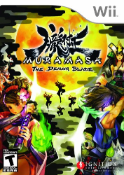Muramasa: The Demon Blade Review
|
|
See PixlBit's Review Policies

On 10/19/2009 at 03:00 PM by Neal Ronaghan The amount of swords in this game rival the amount of original Pokemon. |

If you love beautiful hand-drawn graphics and can tolerate some repetitive gameplay, then this is more than worth your time as there is a lot to do and see.
Muramasa: The Demon Blade, the spiritual successor to developer Vanillaware's Odin Sphere, is a side-scrolling hack-and-slash action game with beautiful hand-drawn artwork and a large world to explore.

Before I go any farther, let me just point out how ridiculously gorgeous this game is. There's a wide variety of different locales, each with their own little effects, such as fog or rain, which look absolutely stunning. Everything in Muramasa, from the smooth movement of the characters to the screen-filling and challenging bosses, is graphically breathtaking.
Sadly, the gameplay isn't as breathtaking. While it is by no means bad, it is just a string of fast-paced fights with a little bit too much of just running around. It is great to gape at the pretty backgrounds, but when you're traversing through damn near 10 rooms that are virtually empty, it gets a bit old.

The combat is simplistic and easy to control. At the outset, you go through a brief tutorial where you learn everything you need to know about the sword-based combat. Basically, you use a combination of one button and different directions to pull off sword attacks, and also use the button to parry, reflect projectiles, and more. You can also perform powerful special attacks and quick draws, the latter of which is done when you change swords. It's intuitive, but in most situations, especially early on, you can just button mash your way to victory. There are no Wii motions to work with, though, and Muramasa can be played with the Wii Remote/Nunchuk combo, a Classic controller, or a GameCube controller.
A key part of combat is sword-switching, since you have three swords equipped and they can break. Each sword has soul power and if one runs out, then it is temporarily broken and the player must switch to another sword. Soul power runs out when you use special attacks, parry, or reflect projectiles. There's a wide variety of blades to choose from, 108 in total, but they're all just incremental upgrades over each other. The coolest part about them is forging, which has a complicated branching upgrade system that goes between both characters. You use spirits and soul to create new swords, and when you create new ones, you can then create the next one on the list.

Muramasa also has a level system where you gain experience from battles, become stronger, and gain the ability to wield more powerful swords. There are also different shops you can go to to buy items that range from maps of different areas to cooking manuals and supplies that can be used to make healing items.
The story features two characters that have their own tale. While there are similarities, the two sides are quite different. The story itself is an amalgamation of various Japanese folklore stories, which makes it understandably foreign to people not familiar with the subject matter. It's a guided experience as there is always an arrow pointing to where you need to go next, but there are optional enemy lairs around that are challenging. Other than that, there's not much reason to explore areas other than gawking at the hand-drawn art. There's a lot to do in the game, as powering through both sides and collecting all 108 swords will take you a long time, but that kind of collecting and playtime is only for the people really into this type of game. If you're not as into hack-and-slash action games with tiny bits of RPG and beautiful art, then you won't enjoy collecting all the swords and playing through the entire game.
Muramasa is a definitely a case of style over substance, but in this case the style is incredible and the substance is ok. It evens out to be a great game that is unfortunately repetitive as you reach the conclusion.










Comments